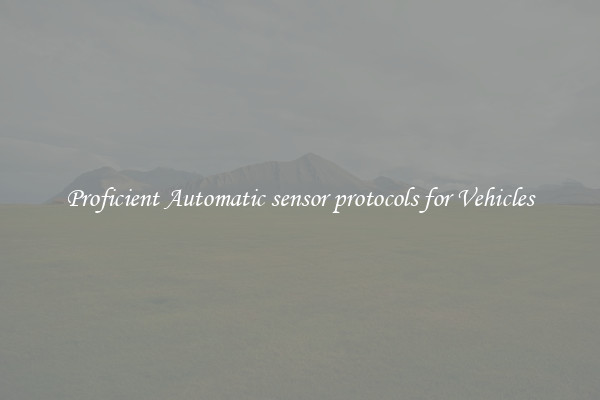Proficient Automatic sensor protocols for Vehicles
Proficient Automatic Sensor Protocols for Vehicles

With the rapid advancement of technology, vehicles are becoming smarter and safer than ever before. One of the key factors contributing to this progress is the implementation of automatic sensor protocols in vehicles. These protocols allow vehicles to collect and process data from their surroundings, enhancing the driving experience and improving safety on the roads.
Automatic sensor protocols enable vehicles to sense their environment by using a range of sensors such as radar, lidar, cameras, and ultrasonic sensors. These sensors can detect objects, measure distances, and identify potential risks or hazards. The collected data is then analyzed and processed by onboard computers to make informed decisions and assist the driver in various ways.
One of the most essential applications of automatic sensor protocols is in the area of advanced driver-assistance systems (ADAS). ADAS technologies use automatic sensors to provide assistance to drivers and increase their awareness of the road conditions. For instance, adaptive cruise control systems use sensors to monitor the distance between vehicles, automatically adjusting the speed to maintain a safe following distance. Lane-keeping assist systems use camera sensors to detect lane markings and steer the vehicle within the lane, reducing the risk of lane departure accidents.
Additionally, automatic sensor protocols play a vital role in the implementation of autonomous driving technologies. Self-driving vehicles heavily rely on these protocols to perceive and navigate their environment. Sensors provide real-time data about road conditions, traffic, and potential obstacles, allowing autonomous vehicles to make accurate decisions and navigate safely without human intervention. As a result, automatic sensor protocols are crucial for the successful development and deployment of autonomous vehicles.
To ensure the proficiency of automatic sensor protocols, standardization is key. By establishing industry-wide standards, manufacturers can ensure compatibility and interoperability between different sensors and vehicles. This ensures that the sensors can communicate effectively and share data seamlessly. Standardization also helps to streamline the development process, reducing costs and ensuring faster implementation.
Furthermore, continuous advancements in sensor technologies are needed to enhance the efficiency and reliability of automatic sensor protocols. Manufacturers are constantly working on improving the accuracy, range, and resolution of sensors, allowing vehicles to see further and detect potential hazards more effectively. This ongoing research and development contribute to the overall improvement of sensor protocols, making vehicles safer and smarter.
In conclusion, proficient automatic sensor protocols are essential for modern vehicles. They enable vehicles to sense and understand their environment, enhancing safety and improving the driving experience. From advanced driver-assistance systems to autonomous driving technologies, automatic sensor protocols play a significant role in shaping the future of transportation. With standardized protocols and continuous advancements in sensor technologies, vehicles can become even more proficient in perceiving their surroundings and ensuring safe and efficient journeys for all.

View details

View details

View details

View details








